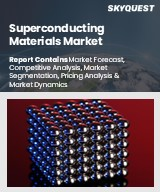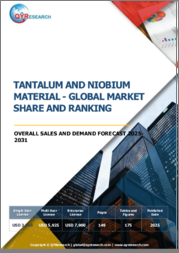
|
시장보고서
상품코드
1394598
세계의 초전도 재료 시장 평가 : 제품 유형별, 요소 유형별, 용도별, 최종사용자별, 지역별, 기회, 예측(2016-2030년)Superconducting Materials Market Assessment, By Product Type, By Element Type, By Application, By End-user, By Region, Opportunities and Forecast, 2016-2030F |
||||||
세계의 초전도 재료 시장 규모는 2022년 20억 7,000만 달러에서 2030년에 46억 달러에 달하며, 2023-2030년의 예측 기간에 CAGR로 10.5%의 성장이 전망됩니다. 재료의 개발과 진보가 초전도 재료의 도입으로 연결되고 있습니다. 의료, 에너지, 운송에서 시장의 확대가 초전도 재료 기술 스펙트럼을 크게 촉진하고 있습니다.
그리드 및 배전 시스템의 개발에 대한 초전도 재료의 포함
유럽위원회는 2030년까지 약 6,330억 달러를 투자하여 첨단화된 유럽 전력망을 개발하는 Digitalization of the energy system을 위한 2022년 행동계획을 시행하고 있습니다. 중국은 이미 2021-2025년 4,420억 달러를 투자하여 전력망 시스템 현대화 및 강화에 대한 노력을 기울이고 있습니다. 미국은 2022년 전력망 업그레이드와 확장을 위해 105억 달러 규모의 GRIP(Grid Resilience Innovative Partnership) 프로그램을 시작했습니다.
자기공명영상 기술을 강화하는 초전도 재료
자기공명영상(MRI) 장비 밀도가 가장 높은 국가는 일본으로 인구 100만 명당 55대 이상이며, 미국, 독일이 그 뒤를 잇고 있습니다. 독일 지멘스는 뛰어난 화질을 구현하는 AI 기반 기술을 탑재한 전신 MRI 스캐너 'Magentom Free Star'를 출시했습니다.
방직 기계에서 자기 베어링으로 초전도 재료의 응용
인도 섬유부Ministry of TextilesMinistry of Textiles가 발표한 데이터에 따르면 FDI는 2017-2022년 섬유 부문에 15억 2,223만 달러를 투자했으며, 2022년 미국에서 생산된 섬유, 섬유, 의류의 총액은 658억 달러 이상에 달할 것으로 예상되며, 섬유 및 직물 수출은 약 340억 달러에 달할 것으로 예상됩니다. 유럽연합(EU) 전체 기업의 약 33%는 섬유를 기반으로 하는 영세기업과 중소기업으로 구성되고 있습니다. 이러한 수치로 미루어 볼 때, 유럽은 기존 기술을 대체할 수 있는 엄청난 기회를 창출할 수 있는 초전도 소재 시장으로서 매우 큰 잠재력을 가지고 있습니다.
COVID-19의 영향
COVID-19의 발생은 초전도 재료를 포함한 많은 부문에 심각한 영향을 미쳐 업무 중단과 노동력 감소를 강요했습니다. 섬유 생산 수요 감소로 인해 자기 베어링의 인기가 떨어지면서 초전도 재료의 통합이 크게 지연되었습니다. 다양한 산업 제조 단위의 폐쇄로 인해 배전망을 관리 할 수있는 자원이 감소하여 초전도 재료 시장이 크게 악화되었습니다.
주요 기업 현황 및 전망
세계 초전도 재료 시장은 과열 및 손실 없는 송전 용량에 대한 수요가 증가함에 따라 꾸준히 성장하고 있으며, Nexans S.A.는 혼잡한 도시 송전망의 대용량 송전을 지원하는 초전도 케이블을 개발했습니다. 3.2GW의 대용량 송전 케이블, HDC 케이블의 전압 레벨은 ±320kV이며, Nexans S.A.는 초전도 케이블 시스템 및 초전도 한류기 제조 분야에서 세계 선두를 달리고 있습니다. 또한 프랑스 교통수단에 초전도 케이블을 깔고 스마트 시티 그리드를 개발하는 등 놀라운 인프라를 구축하여 전력 전송의 미래를 만들어가고 있습니다.
2021년 9월, 넥상스(Nexans S.A.)는 시카고의 탄력성 전력망 프로젝트에 초전도 케이블을 설치하여 시운전을 진행했습니다. 이는 예측할 수 없는 날씨와 심각한 재난으로부터 전력망을 보호하는 데 필수적입니다.
세계의 초전도 재료 시장에 대해 조사분석했으며, 시장 규모와 예측, 시장 역학, 주요 기업의 상황과 전망 등을 제공하고 있습니다.
목차
제1장 조사 방법
제2장 프로젝트의 범위와 정의
제3장 세계의 초전도 재료 시장에 대한 COVID-19의 영향
제4장 주요 요약
제5장 고객의 소리
- 시장 인지도와 제품 정보
- 브랜드 인지도와 로열티
- 구입 결정에서 고려된 요소
- 구입 빈도
- 구입 매체
제6장 세계의 초전도 재료 시장 전망(2016-2030년)
- 시장 규모와 예측
- 금액
- 수량
- 제품 유형별
- 고온초전도체(HTS)
- 저온초전도체(LTS)
- 액체냉각초전도체(LCS)
- 요소 유형별
- 구리
- 황동
- 스테인리스강
- 기타
- 용도별
- 자기공명영상(MRI)
- 나노재료
- 차량용 베어링
- 송전 케이블
- 기타
- 최종사용자별
- 의료
- 운송
- 텍스타일 산업
- 전력망
- 기타
- 지역별
- 북미
- 유럽
- 남미
- 아시아태평양
- 중동 및 아프리카
- 시장 점유율 : 기업별(2022년)
제7장 세계의 초전도 재료 시장 전망 : 지역별(2016-2030년)
- 북미
- 시장 규모와 예측
- 제품 유형별
- 요소 유형별
- 용도별
- 최종사용자별
- 미국
- 캐나다
- 멕시코
- 유럽
- 독일
- 프랑스
- 이탈리아
- 영국
- 러시아
- 네덜란드
- 스페인
- 터키
- 폴란드
- 남미
- 브라질
- 아르헨티나
- 아시아태평양
- 인도
- 중국
- 일본
- 호주
- 베트남
- 한국
- 인도네시아
- 필리핀
- 중동 및 아프리카
- 사우디아라비아
- 아랍에미리트
- 남아프리카공화국
제8장 공급측 분석
- 생산능력 : 기업별
- 생산 : 기업별
- 운전 효율 : 기업별
- 주요 공장 소재지(최대 25)
제9장 시장 매핑(2022년)
- 제품 유형별
- 요소 유형별
- 용도별
- 최종사용자별
- 지역별
제10장 거시환경과 산업 구조
- 수급 분석
- 수출입 분석
- 서플라이/밸류체인 분석
- PESTEL 분석
- Porter's Five Forces 분석
제11장 시장 역학
- 성장 촉진요인
- 성장 억제요인(과제, 억제요인)
제12장 주요 기업 상황
- 시장 리더 상위 5사의 경쟁 매트릭스
- 시장 리더 상위 5사의 시장 매출 분석(2022년)
- 합병과 인수/합병사업(해당하는 경우)
- SWOT 분석(시장 참여 기업 5사)
- 특허 분석(해당하는 경우)
제13장 가격 분석
제14장 사례 연구
제15장 주요 기업의 전망
- Bruker Corporation
- Cryomagnetics, Inc.
- American Superconductor
- Nexans S.A.
- Sumitomo Electric Industries, Ltd.
- Evico GmbH
- Western Superconducting Technologies Co. Ltd.
- Hitachi, Ltd.
- Southwire Company LLC
- Western Superconducting Technologies Co, Ltd.
제16장 전략적 권장사항
제17장 Market Xcel - Markets and Data 소개, 면책사항
KSA 23.12.21Global superconducting materials market size was valued at USD 2.07 billion in 2022, expected to reach USD 4.6 billion in 2030, with a CAGR of 10.5% for the forecast period between 2023 and 2030. The development and advancement in materials has led to the introduction of superconducting materials. The growing market in healthcare, energy, and transportation has significantly driven the technologies spectrum for superconducting materials.
High temperature superconductors are used for round conductors and solenoid applications in healthcare and electrical sectors. Superconducting magnetic systems are truly reliable and deliver high performance by ensuring safety parameters, used as current limiters and in lead applications. Superconductor magnetic bearing is used in high-speed textile and processing machines to run dynamic yarn processing effectively. Resilient electric grid is developed using advanced superconducting materials using high power medium voltage cable technology.
Incorporation of Superconducting Materials in Developing Electric Grid and Distribution System
Considering the objective of net zero goals transport, heating and similar industries need to be electrified during the upcoming years. Superconducting cables are potentially great to transmit humongous electricity in a small space for congested urban grids. Superconducting cables transform urban power by eliminating heating, electric and magnetic fields. High temperature superconductors make power grid units and transmission cables by providing cryogenic compound insulation, usually liquid nitrogen surrounding the cable.
Brass metal is extensively used in high-current AC or DC applications like power transmission and distribution without affecting the voltage and providing high strength and stability. Copper metal find the application in power dense coils for developing synchronous motors, generators, and magnets. The market for superconducting materials can be emphasized as its incorporation in building resilience electrical power grid and distribution network.
The European Commission has executed an action plan for 2022 for "Digitalization of the energy system" to invest around USD 633 billion by 2030 to develop an advanced European electricity grid. China has already implemented measures to modernize and enhance the power grid system by investing USD 442 billion from 2021 to 2025. The United States commenced the Grid Resilience Innovative Partnership (GRIP) program in 2022 with a funding amount of USD 10.5 billion with the objective to upgrade and expand grid networks.
Superconducting Materials to Augment the Technology of Magnetic Resonance Imaging
The conventional equipment for performing magnetic resonance imaging usually takes around 1-2 hours, but with the introduction of superconducting materials, the MRI examination time has come down to minutes. Superconductivity is considered important for MRI scanning devices that assist in creating unprecedented views of structures deep inside the human body. Conventional MRI with novel elements, like magnesium and titanium, can generate magnetic fields at higher rates. For instance, Hitachi has exceptionally developed a 1.1-m-diameter magnesium bromide superconducting magnet where the time required to perform MRI examinations is 10 minutes. All modern MRI scanners are equipped with niobium-titanium (NbTi) superconducting materials with multiple NbTi microfilaments embedded in a copper core. These advanced MRI scanners provides superior soft-tissue imaging to assist doctors in predicting various diseases like cancer, Alzheimer, trauma injury, etc.
Japan has the highest density of magnetic resonance imaging (MRI) units, accounting for over 55 units per every million of its population, followed by the United States and Germany. Siemens in Germany has commenced a whole-body MRI scanner Magentom Free Star that is enabled with AI-based technology that generates superior image quality.
Applications of Superconducting Materials as a Magnetic Bearing in Textile Machines
Cooled superconductors require an additional positioning system, which is significantly replaced by superconductor magnetic bearings in a stable position. Shock-staple yarn production is progressively achieved by the ring spinning technique operating at a maximum speed of 25,000 rpm and is widely adopted across the textile industry. The SMBs are used as twist elements that comprise a rotating permanent-magnetic ring that handles the yarn twisting. The problem of friction-induced heat generation in the ring-traveler twist element during ring spinning is overcome through superconductive magnetic bearings.
Data released by the Ministry of Textiles, India states that FDI has invested USD 1522.23 million in the textile sector from 2017-2022. In 2022, the net value of the United States manufactured fiber, textile, and apparel shipments accounted for an estimated over USD 65.8 billion, whereas the export of fibers and textiles contributed to around USD 34 billion. Around 33% of companies across the European Union are textile-based, accounting for micro and SMEs. With such impeccable figures, Europe has extreme potential for a superconducting materials market that generates phenomenal opportunities to replace conventional technologies.
Impact of COVID-19
The outbreak of COVID-19 severely impacted numerous sectors with a shutdown of industrial operations due to imposed lockdowns and less workforce, including Superconducting Materials. The lowering demand for textile production has substantially de-structured the incorporation of superconducting materials as the magnetic bearing was significantly discouraged. The closure of various industrial manufacturing units has reduced resources to manage the electric-grid distribution network which substantially degraded the market of superconducting materials.
Key Players Landscape and Outlook
The global superconducting materials market is successfully growing with the increasing demand for power transmission capacity without overheating and losses. Nexans S.A. has developed superconducting cables that assist in transmitting large electricity for congested urban grids. Transmission cables have a massive capacity of 3.2 GW with a voltage level of ± 320 kV for HDC cables. Nexans S.A. is leading globally in manufacturing superconducting cable systems and superconducting fault current limiters. They are involved in creating incredible infrastructure and shaping the future of electrical transmission, like installing superconducting cables in French transportation, developing smart city grids, etc.
In September 2021, Nexans S.A. installed and commissioned superconducting cables for Chicago's resilient electric grid project that are imperative in preventing power grids from unpredictable weather and severe catastrophic events.
Table of Contents
1. Research Methodology
2. Project Scope & Definitions
3. Impact of COVID-19 on Global Superconducting Materials Market
4. Executive Summary
5. Voice of Customer
- 5.1. Market Awareness and Product Information
- 5.2. Brand Awareness and Loyalty
- 5.3. Factors Considered in Purchase Decision
- 5.3.1. Brand Name
- 5.3.2. Quality
- 5.3.3. Quantity
- 5.3.4. Price
- 5.3.5. Product Specification
- 5.3.6. Application Specification
- 5.3.7. Shelf-life
- 5.3.8. Availability of Product
- 5.4. Frequency of Purchase
- 5.5. Medium of Purchase
6. Global Superconducting Materials Market Outlook, 2016-2030F
- 6.1. Market Size & Forecast
- 6.1.1. By Value
- 6.1.2. By Volume
- 6.2. By Product Type
- 6.2.1. High Temperature Superconductor (HTS)
- 6.2.2. Less Temperature Superconductor (LTS)
- 6.2.3. Liquid Cooled Superconductors (LCS)
- 6.3. By Element Type
- 6.3.1. Copper
- 6.3.2. Brass
- 6.3.3. Stainless Steel
- 6.3.4. Others
- 6.4. By Application
- 6.4.1. Magnetic Resonance Imaging (MRI)
- 6.4.2. Nanomaterials
- 6.4.3. Vehicle Bearings
- 6.4.4. Power Transmission Cables
- 6.4.5. Others
- 6.5. By End-user
- 6.5.1. Healthcare
- 6.5.2. Transportation
- 6.5.3. Textile Industry
- 6.5.4. Electric Power Grids
- 6.5.5. Others
- 6.6. By Region
- 6.6.1. North America
- 6.6.2. Europe
- 6.6.3. South America
- 6.6.4. Asia-Pacific
- 6.6.5. Middle East and Africa
- 6.7. By Company Market Share (%), 2022
7. Global Superconducting Materials Market Outlook, By Region, 2016-2030F
- 7.1. North America*
- 7.1.1. Market Size & Forecast
- 7.1.1.1. By Value
- 7.1.1.2. By Volume
- 7.1.2. By Product Type
- 7.1.2.1. High Temperature Superconductor (HTS)
- 7.1.2.2. Less Temperature Superconductor (LTS)
- 7.1.2.3. Liquid Cooled Superconductors (LCS)
- 7.1.3. By Elements Type
- 7.1.3.1. Copper
- 7.1.3.2. Brass
- 7.1.3.3. Stainless Steel
- 7.1.3.4. Others
- 7.1.4. By Application
- 7.1.4.1. Magnetic Resonance Imaging (MRI)
- 7.1.4.2. Nanomaterials
- 7.1.4.3. Vehicle Bearings
- 7.1.4.4. Power Transmission Cables
- 7.1.4.5. Others
- 7.1.5. By End-user
- 7.1.5.1. Healthcare
- 7.1.5.2. Transportation
- 7.1.5.3. Textile Industry
- 7.1.5.4. Electric Power Grids
- 7.1.5.5. Others
- 7.1.6. United States*
- 7.1.6.1. Market Size & Forecast
- 7.1.6.1.1. By Value
- 7.1.6.1.2. By Volume
- 7.1.6.2. By Product Type
- 7.1.6.2.1. High Temperature Superconductor (HTS)
- 7.1.6.2.2. Less Temperature Superconductor (LTS)
- 7.1.6.2.3. Liquid Cooled Superconductors (LCS)
- 7.1.6.3. By Element Type
- 7.1.6.3.1. Copper
- 7.1.6.3.2. Brass
- 7.1.6.3.3. Stainless Steel
- 7.1.6.3.4. Others
- 7.1.6.4. By Application
- 7.1.6.4.1. Magnetic Resonance Imaging (MRI)
- 7.1.6.4.2. Nanomaterials
- 7.1.6.4.3. Vehicle Bearings
- 7.1.6.4.4. Power Transmission Cables
- 7.1.6.4.5. Others
- 7.1.6.5. By End-user
- 7.1.6.5.1. Healthcare
- 7.1.6.5.2. Transportation
- 7.1.6.5.3. Textile Industry
- 7.1.6.5.4. Electric Power Grids
- 7.1.6.5.5. Others
- 7.1.7. Canada
- 7.1.8. Mexico
- 7.1.1. Market Size & Forecast
All segments will be provided for all regions and countries covered:
- 7.2. Europe
- 7.2.1. Germany
- 7.2.2. France
- 7.2.3. Italy
- 7.2.4. United Kingdom
- 7.2.5. Russia
- 7.2.6. Netherlands
- 7.2.7. Spain
- 7.2.8. Turkey
- 7.2.9. Poland
- 7.3. South America
- 7.3.1. Brazil
- 7.3.2. Argentina
- 7.4. Asia-Pacific
- 7.4.1. India
- 7.4.2. China
- 7.4.3. Japan
- 7.4.4. Australia
- 7.4.5. Vietnam
- 7.4.6. South Korea
- 7.4.7. Indonesia
- 7.4.8. Philippines
- 7.5. Middle East & Africa
- 7.5.1. Saudi Arabia
- 7.5.2. UAE
- 7.5.3. South Africa
8. Supply Side Analysis
- 8.1. Capacity, By Company
- 8.2. Production, By Company
- 8.3. Operating Efficiency, By Company
- 8.4. Key Plant Locations (Up to 25)
9. Market Mapping, 2022
- 9.1. By Product Type
- 9.2. By Element Type
- 9.3. By Application
- 9.4. By End-user
- 9.5. By Region
10. Macro Environment and Industry Structure
- 10.1. Supply Demand Analysis
- 10.2. Import Export Analysis
- 10.3. Supply/Value Chain Analysis
- 10.4. PESTEL Analysis
- 10.4.1. Political Factors
- 10.4.2. Economic System
- 10.4.3. Social Implications
- 10.4.4. Technological Advancements
- 10.4.5. Environmental Impacts
- 10.4.6. Legal Compliances and Regulatory Policies (Statutory Bodies Included)
- 10.5. Porter's Five Forces Analysis
- 10.5.1. Supplier Power
- 10.5.2. Buyer Power
- 10.5.3. Substitution Threat
- 10.5.4. Threat from New Entrant
- 10.5.5. Competitive Rivalry
11. Market Dynamics
- 11.1. Growth Drivers
- 11.2. Growth Inhibitors (Challenges, Restraints)
12. Key Players Landscape
- 12.1. Competition Matrix of Top Five Market Leaders
- 12.2. Market Revenue Analysis of Top Five Market Leaders (in %, 2022)
- 12.3. Mergers and Acquisitions/Joint Ventures (If Applicable)
- 12.4. SWOT Analysis (For Five Market Players)
- 12.5. Patent Analysis (If Applicable)
13. Pricing Analysis
14. Case Studies
15. Key Players Outlook
- 15.1. Bruker Corporation
- 15.1.1. Company Details
- 15.1.2. Key Management Personnel
- 15.1.3. Products & Services
- 15.1.4. Financials (As reported)
- 15.1.5. Key Market Focus & Geographical Presence
- 15.1.6. Recent Developments
- 15.2. Cryomagnetics, Inc.
- 15.3. American Superconductor
- 15.4. Nexans S.A.
- 15.5. Sumitomo Electric Industries, Ltd.
- 15.6. Evico GmbH
- 15.7. Western Superconducting Technologies Co. Ltd.
- 15.8. Hitachi, Ltd.
- 15.9. Southwire Company LLC
- 15.10. Western Superconducting Technologies Co, Ltd.
Companies mentioned above DO NOT hold any order as per market share and can be changed as per information available during research work.













